A typical panic room, designed for emergency shelter, varies in size from 25 square feet (2 square meters) to 35 square feet (3 square meters) for 1-2 people and is equipped with essentials like a small toilet and emergency supplies. Larger panic rooms of 35 to 55 square feet (3 to 5 square meters) accommodate additional amenities like fold-down cots and food rations. Panic rooms serve multiple purposes: providing a secure refuge during emergencies, safeguarding valuables, resisting severe weather, offering peace of mind through security reassurance, and maintaining emergency readiness. Furniture in a panic room includes storage cabinets for emergency supplies, reinforced seating, folding beds or cots, a secure safe for valuables, communication equipment, and a ventilation system. Typical color schemes in panic rooms include gray, white, beige, blue, green, black, and red. Insulation, proper ventilation, innovative technology, and renewable energy sources enhance energy efficiency in panic rooms. Renovating a panic room typically costs between $5,000 (€4,500, £3,800) and $15,000 (€13,500, £11,400), influenced by the room’s size, security features, communication systems, ventilation, power and backup systems, supplies, and budget constraints. An architect’s role in upgrading a panic room encompasses enhancing security, ventilation, space optimization, lighting, communication, and material durability. Homeowners struggle with ensuring optimal security, balancing comfort and security, adhering to regulations, managing space, integrating technology, providing ventilation and sustainability, and coordinating with specialists and contractors during redecoration.
What is the typical size of a panic room?
A typical panic room ranges from 25 square feet (2 square meters) to 35 square feet (3 square meters). This space provides emergency temporary shelter for 1-2 people in case of a home invasion or intruder. The confined footprint holds essentials like a small toilet, bottled water, emergency phone, and monitors without extra furnishings beyond a bench. The ceiling height matches residence standards of 8 feet (2.4 meters), but the enclosed setting feels tighter.
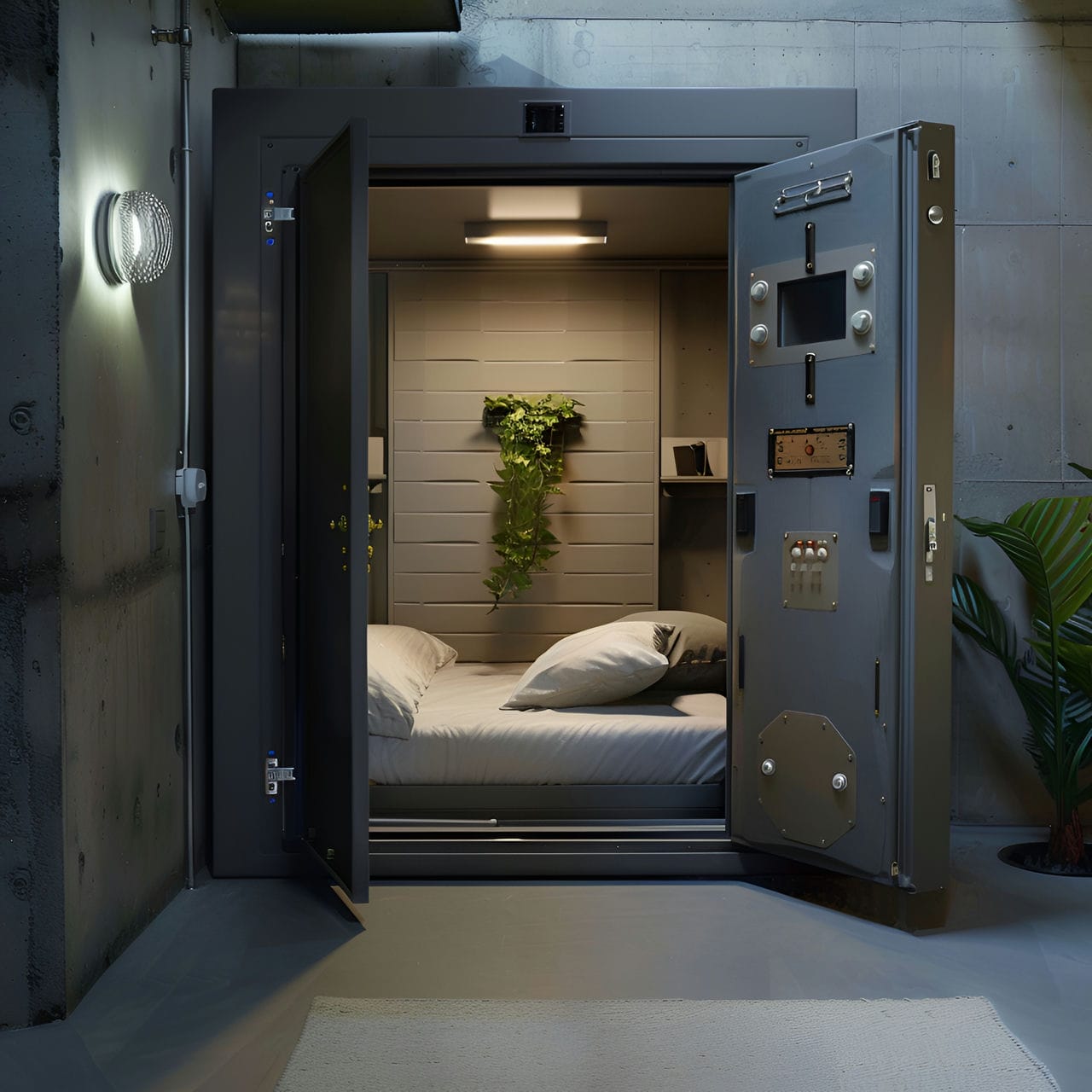
The average panic room measures 35 square feet (3 square meters) to 55 square feet (5 square meters), providing minimal space for supplementary amenities. The ceiling height meets residential standards at 8 feet (2.4 meters), though the security-focused setting maintains a cramped protective atmosphere. An average panic room footprint holds emergency toiletries, food rations, fold-down cots, first aid, and small battery-powered appliances relying on enclosed self-sufficiency.
Elite luxury home panic rooms with miniature bunker-style specifications can exceed 80 square feet (7 square meters). Soaring 10-foot (3-meter) ceilings add respiration while thick security doors with internal locks seal the chamber. Outfitted as entirely disconnected underground vaults, these contain independent ventilation systems and power redundancies running surveillance internally and property-wide.
What is the use and purpose of a panic room?
The purpose of a panic room is to provide protective refuge, safeguarding valuables, weather resistance, security reassurance, and emergency readiness. Firstly, a panic room provides a secure hiding place inside a home or building to shelter occupants during dangerous situations like invasions, burglaries, or severe weather events. It is a fortified, windowless room designed for safety and security when under attack or threat. Secondly, some panic rooms are designed to safeguard valuables like artwork, collectibles, or computer equipment, even when unoccupied. Thirdly, panic rooms are built for weather resistance to shield people from tornados or hurricanes. These may be located in basements or ground-floor bathrooms for structural integrity to withstand high winds and debris. Fourthly, panic rooms offer peace of mind to homeowners worried about security risks by providing an impenetrable stronghold during emergencies. Features like communications systems, cameras, backup power, water, and supplies enable prolonged lockdowns. Lastly, recent innovations allow panic rooms to avoid feeling claustrophobic and serve multiple purposes when not needed for safety. Some have screens to maintain situational awareness or connections to other areas of the home for expanded space.
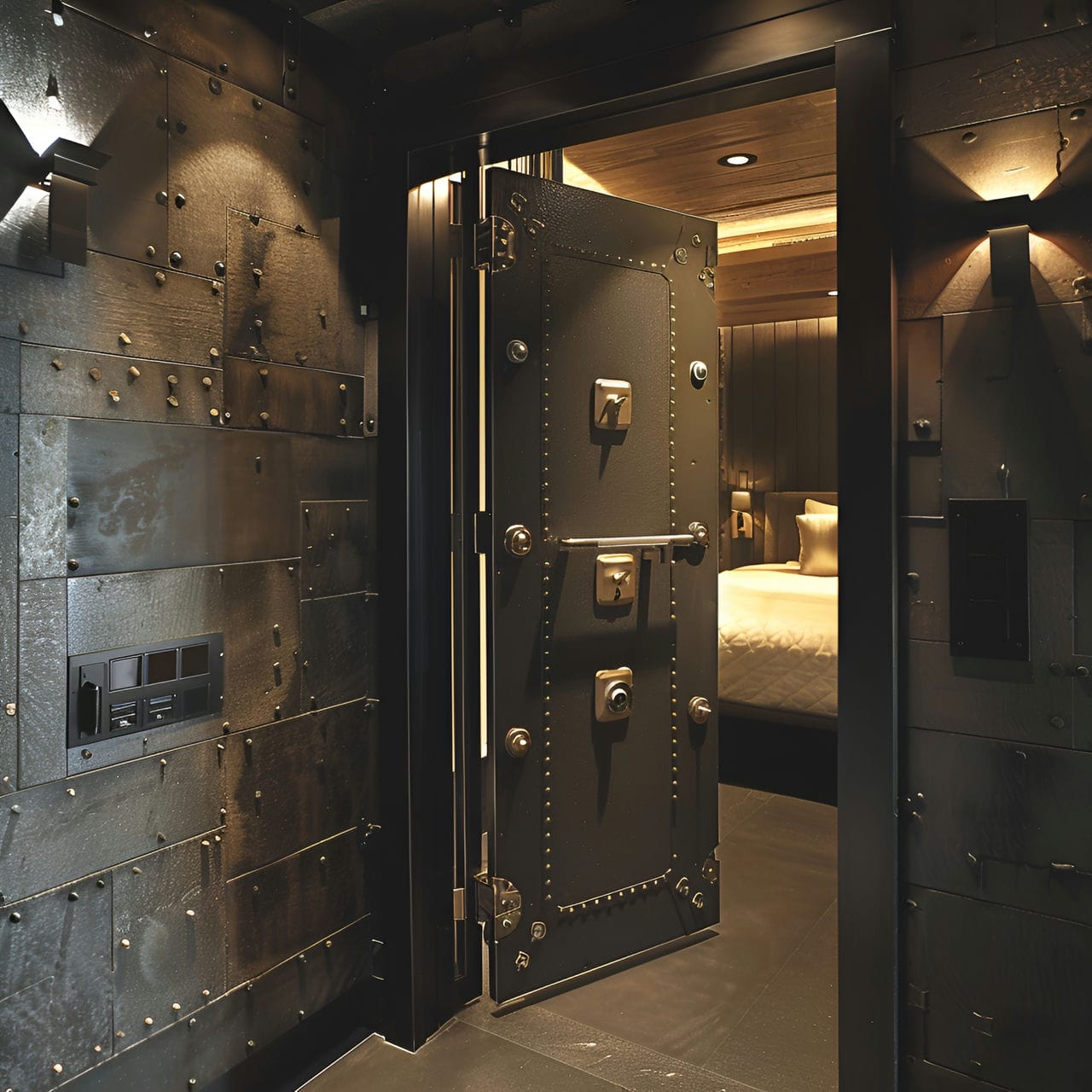
What is the typical shape of a panic room?
The typical shapes of a panic room are rectangular or square, spanning 20 square feet (1.5 square meters) to 30 square feet (2.5 square meters) against the selected residential exterior fortification point. Width ranges from 20 square feet (1.5 meters) to 25 square feet (2 meters), securing emergency essential systems like small water reserves, rations, fold-down cots, and toiletries scaled to minimum capacity for short underground durations. Equal side lengths ranging from 20 square feet (1.5 square meters) to 30 square feet (2.5 square meters) deliver identical crisis equipment access from all angles. Low ceiling heights of 8 feet (2.4 meters) retain an enclosed protective atmosphere as occupancy remains secondary to privacy.
What furniture commonly equips a panic room?
Listed below are the types of furniture commonly equip a panic room:
- Storage cabinets: Storage cabinets in a panic room are crucial for organizing and securing emergency supplies. These furniture cabinets are made from sturdy, durable materials like steel to withstand potential break-ins or impact. They feature lockable doors for added security. Storage cabinets in a panic room store non-perishable food, water, first aid kits, and other essentials.
- Reinforced seating: Reinforced seating in a panic room provides a safe and durable place to sit during an emergency. These furniture seats are usually made from heavy-duty materials like steel or reinforced plastic and are designed to be comfortable yet robust.
- Folding beds or cots: Folding beds or cots in a panic room offer a compact sleeping solution. Designed to be space-efficient, these furniture can be easily stored when not in use. They are made from lightweight but durable materials, providing enough comfort for short-term use.
- Secure safe: A secure safe in a panic room protects valuables and important documents. These furniture are made from heavy-duty steel with combination or biometric locks for enhanced security. A safe in a panic room ensures that items like cash, passports, or sensitive documents are protected during emergencies and are accessible to authorized individuals.
- Communication equipment: Communication equipment in a panic room is vital for maintaining contact with the outside world. This furniture includes a landline phone, a radio, or a dedicated communication system that remains operational even if regular lines are cut.
- Ventilation system: A ventilation system in a panic room is essential for providing fresh air and maintaining a comfortable environment. These furniture are often discrete and tamper-proof, ensuring they cannot be easily disabled from the outside.
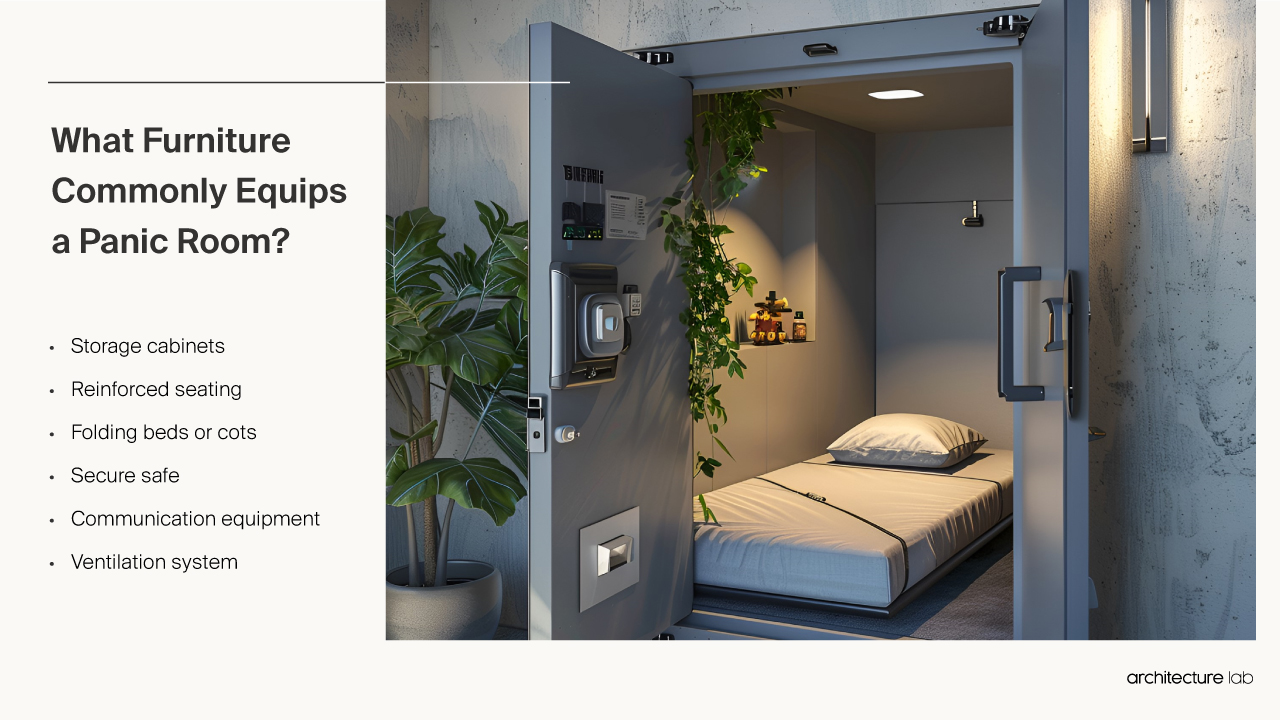
What is the normal ceiling height of a panic room?
The normal ceiling height of a panic room spans 26 square feet (2.4 square meters) to 29 square feet (2.7 square meters). Minimum panic room ceiling clearance enables occupants to sit or stand safely at typical heights in the confined, secure setting without infringement from overhead structures. Luxury panic rooms buried underground as detached bunkers beneath properties may incorporate higher ceilings starting at 27 square feet (2.5 square meters), given their spacious concealed dimensions emulate other live-in room formats. Above-grade panic rooms hidden cleanly within homes retain more limited squat clearance between 26 square feet (2.4 square meters) and 27 square feet (2.5 square meters). Anything lower risks occupant safety and mobility, while excessive height for an intentionally compact fortified space dilutes its private protective utility.
What colors are panic rooms usually painted?
Listed below are the paint colors usually used in panic rooms:
- Gray: Panic rooms feature gray colors for their neutrality and practicality. Shades range from light slate to dark charcoal, chosen for their hidden nature. Gray is preferred as it doesn’t stimulate or distract, maintaining a calm environment.
- White: White colors are used in panic rooms to create a sense of spaciousness. From pure white to soft cream, this color helps make the room feel less confining. White reflects light, which is important in a space with limited lighting.
- Beige: Beige colors are standard in panic rooms, providing a calming and neutral environment. Ranging from light sand to richer taupe, this color offers a warm yet unassuming backdrop.
- Blue: Blue colors in panic rooms are chosen for their calming effect. Blue is beneficial in stressful situations, as it can have a soothing impact on the mind. It is an accent color, balancing the need for calmness without making the space feel too stark.
- Green: Green colors in panic rooms mimic the calming. Shades such as sage, olive, or forest green are selected for their soothing properties. Green can help create a less clinical and more comfortable environment, which is vital in a space designed for safety and security.
- Black: Black colors are used in panic rooms for their practicality. While not typical due to the potential for making spaces feel smaller, black is chosen in specific design contexts. It is used for concealing technology or security equipment, blending them into the background.
- Red: Red colors are sometimes used in panic rooms for specific purposes. Bright red might highlight emergency equipment or features, such as escape routes or essential controls. Red accents are balanced with more neutral tones to maintain a calm environment.
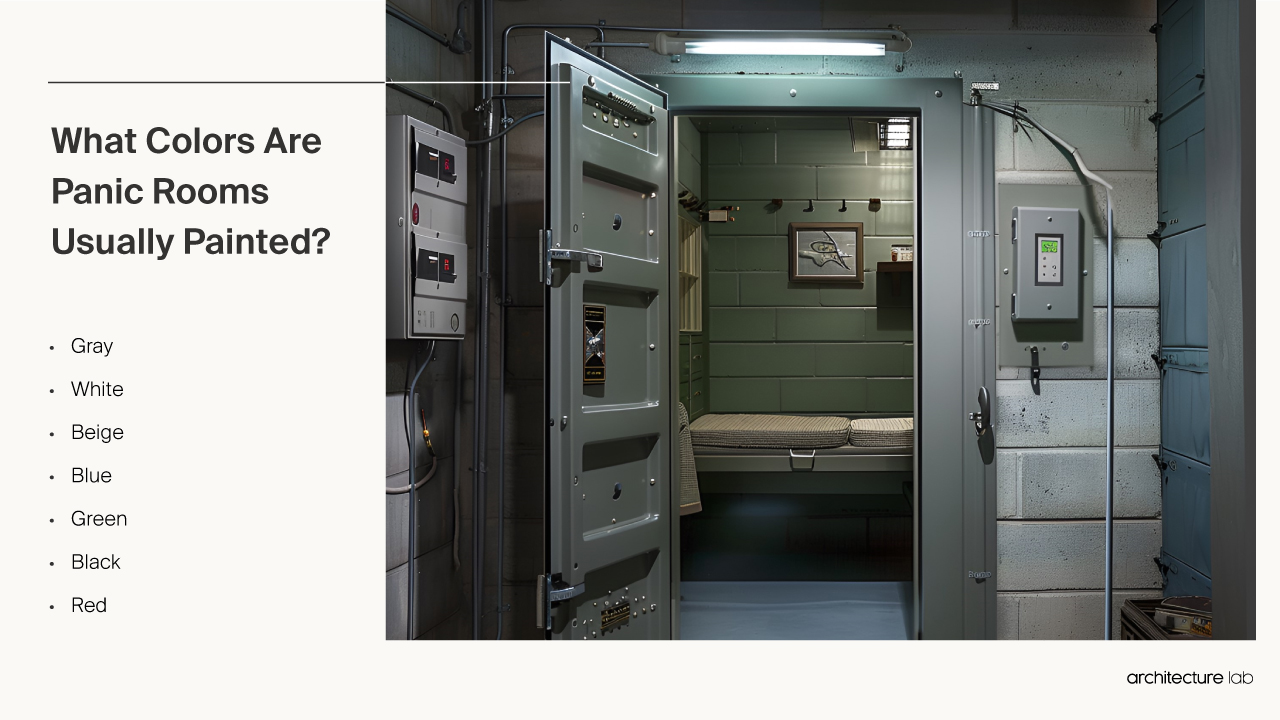
What makes the panic room functional?
The panic room is functional by protective construction, emergency provisions, strategic placement, and unique features. Firstly, the primary purpose of a panic room is to provide emergency shelter and protection for homeowners during dangerous situations like home invasions, burglaries, severe weather events, or other threats. A functional panic room needs fortified construction, including reinforced walls, ceilings, doors, and locks that can withstand attacks and keep intruders out. Secondly, the room should contain basic survival supplies to allow residents to wait out the threat safely. Essential provisions like non-perishable food, water, first aid kits, flashlights, and battery-powered devices will enable people to remain in the secured room for hours or days if needed. Communication equipment like phones, radios, or intercoms also allows contacting police or emergency services. Thirdly, the panic room location impacts functionality. Installing it on a lower level or interior room without windows enhances security. Locating it near bedrooms or shared living areas ensures quick access in an emergency. Concealing the entrance behind a hidden door or bookcase keeps the room discreet. Lastly, specialized features may improve safety and security. Steel plating around walls and doors resists ballistic damage. Surveillance cameras let occupants monitor threats externally. Backup power systems maintain electricity and ventilation if utilities fail.
How is energy efficiency achieved in a panic room?
Energy efficiency is achieved in a panic room through effective insulation, proper ventilation, innovative technology, and renewable energy sources. Firstly, insulation is a critical factor in maintaining energy efficiency. This involves sealing any leaks or gaps that could allow air to escape, thus wasting the energy used to heat or cool the room. This helps maintain a consistent room temperature, reducing the need for excessive heating or cooling. Secondly, ventilation is another important aspect. A well-designed ventilation system can help to retain heat and manage humidity levels within the room. This is important in a panic room, where the air quality needs to be maintained for the occupant’s safety and comfort. Thirdly, integrating smart home automation systems can significantly enhance energy efficiency. These systems can monitor and optimize energy consumption, ensuring efficient utilization of resources. Smart appliances can adjust operations based on usage patterns, minimizing energy wastage. Lastly, other measures can be taken to improve energy efficiency. Renewable energy sources, such as solar panels and greenhouse efficiency, can reduce reliance on traditional sources and contribute to energy savings.
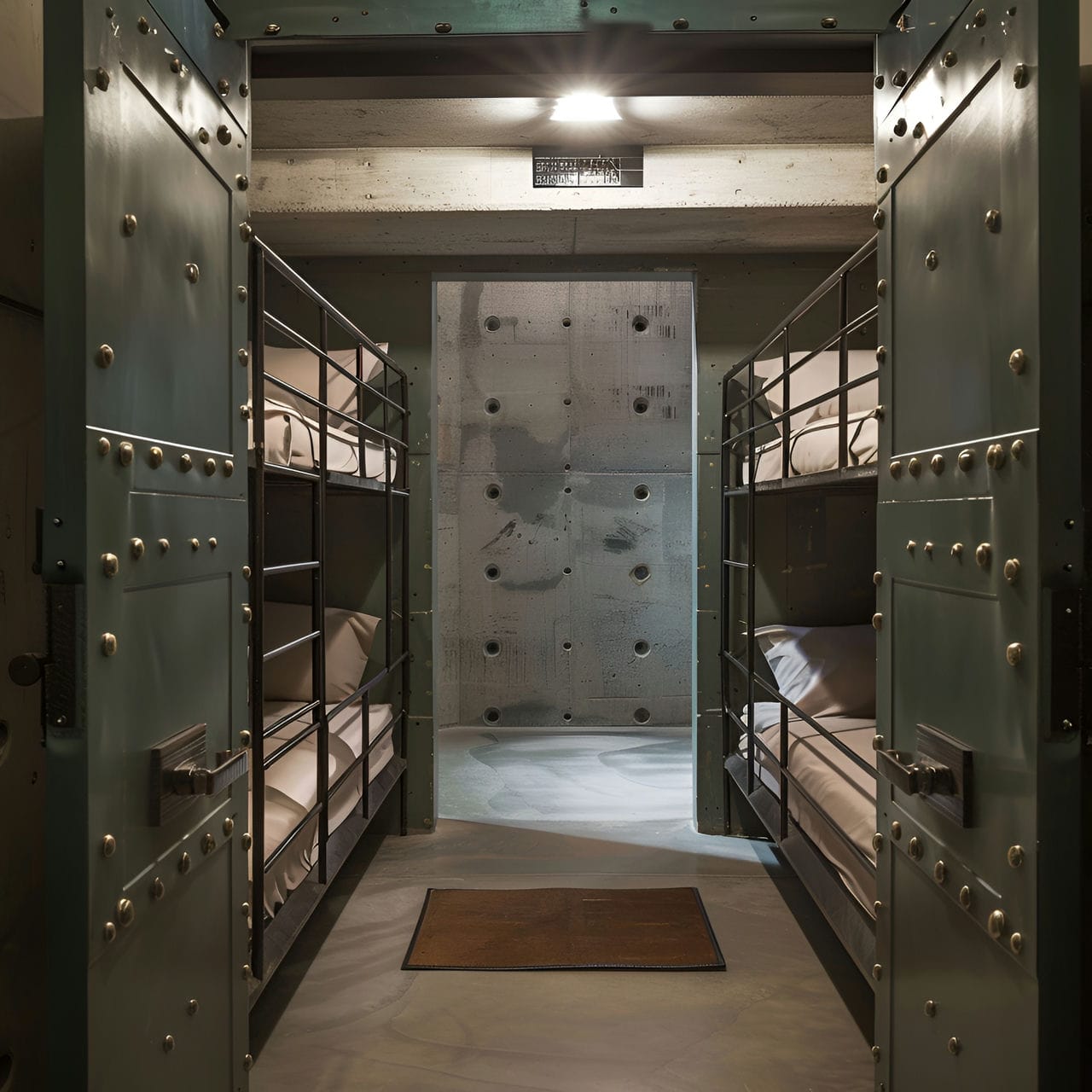
How much does it typically cost to renovate a panic room?
The average cost to renovate an existing 25 square foot to 35 square foot (2 square meters to 3 square meters) panic room falls between $5,000 (€4,500, £3,800) to $15,000 (€13,500, £11,400). Building a new fortified hideaway space concealed neatly into existing properties requires specialized demolition, concrete/steel reinforcement installation, layout adjustments, and finishes, driving prices toward $15,000 (€13,500, £11,400). Factory-fabricated modular inserts avoiding major teardowns average closer to $5,000 (€4,500, £3,800). Bullet-resistant metal plating and solid core wood blocking to secure entry doors and observational peepholes cost $3,000 (€2,700, £2,300). WiFi extending connectivity, including CCTV systems, spans $2,000 (€1,800, £1,500) to $4,000 (€3,600, £3,000). Wall-mounted 72-hour supply caches for water, freeze-dried food rations, and toilet bucket liners average $500 (€450, £375). Expect investment budgets beyond $30,000 (€27,000, £22,500). Typical discreet panic hideaways range from $5,000 (€4,500, £3,800) to $10,000 (€9,000, £7,600) on average. Luxury underground facilities require assessments akin to commercial storm shelters costing $25,000+ (€22,500+ £18,900+).
What factors affect the panic room renovation?
Listed below are the factors that affect the panic room renovation:
- Size and layout: The size and design of a panic room impact its renovation. A more oversized panic room can accommodate more features and supplies, while a smaller space requires efficient use of every inch. Renovation plans must consider the existing structure, assessing whether to expand or modify the space.
- Security features: Security features are critical in a panic room renovation. Upgrades include reinforced doors, bulletproof walls, and advanced locking mechanisms. The level of security required depends on the perceived threat level and personal preferences.
- Communication systems: Installing reliable communication systems is vital in a panic room renovation. Systems such as a landline phone, an internet connection, or a dedicated intercom are crucial for maintaining contact with the outside world during emergencies.
- Ventilation and air filtration: Proper ventilation and air filtration systems are essential to a panic room renovation. These systems ensure a supply of fresh air and can protect against airborne contaminants or gases.
- Power and backup systems: Power supply and backup systems are crucial in a panic room renovation. Ensuring an uninterrupted power supply involves installing generators or batteries, which are critical for maintaining lighting, communication, and security systems during power outages.
- Supplies and storage: Adequate supplies and solutions are important in a panic room renovation. Storage for emergency supplies such as food, water, medical kits, and other essentials must be incorporated into the design.
- Budget and financial constraints: The budget and financial constraints play a significant role in a panic room renovation. A higher budget allows for more advanced security features, better communication systems, and more comfortable furnishings.
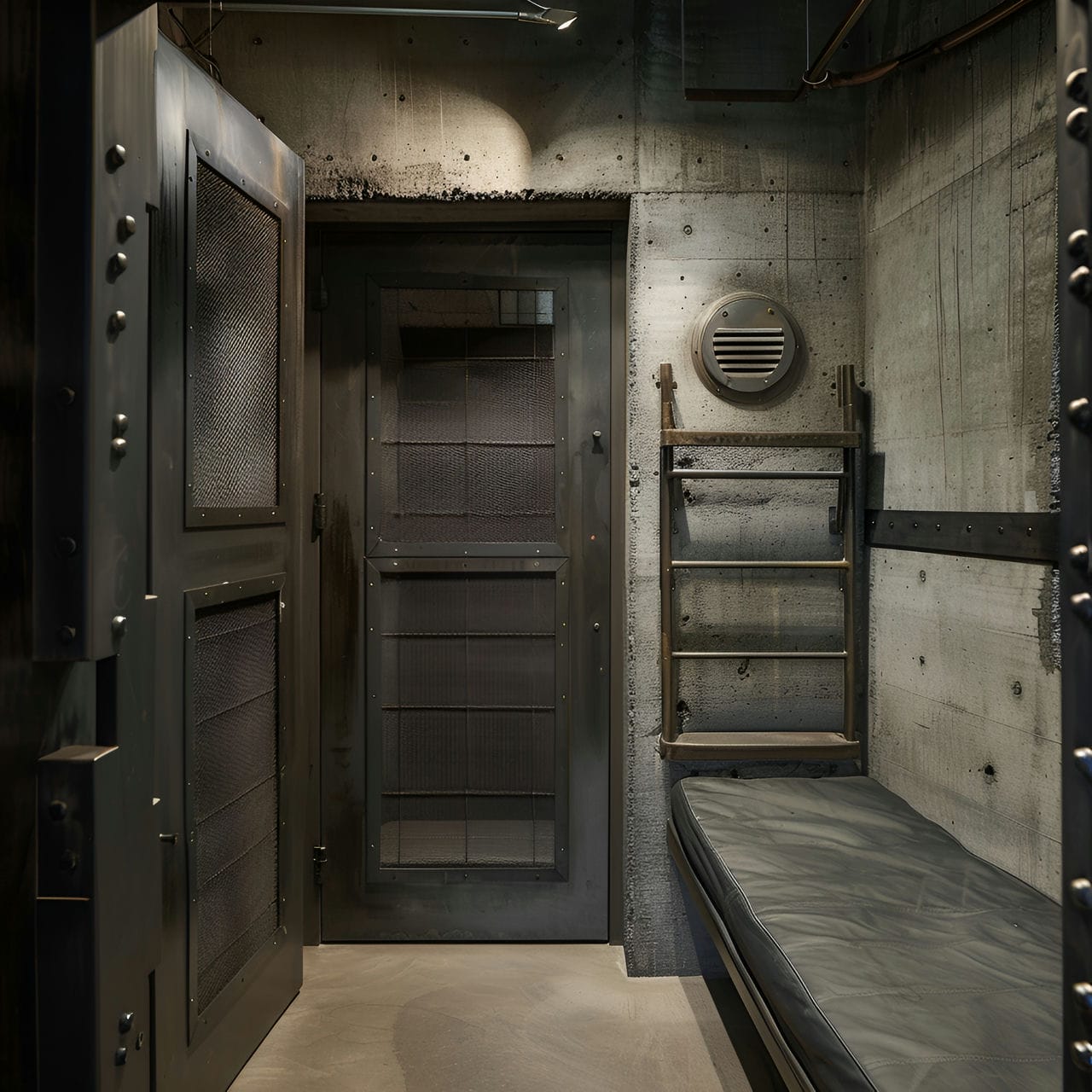
Is an architect required to renovate a panic room?
No, an architect is not required to renovate a panic room, but it is highly advised to hire one. The unique nature of a panic room, designed for security and safety, means that renovations should be approached with expertise and precision – attributes that architects possess. Architects can optimize the use of limited space, integrating advanced security features, robust materials, and efficient ventilation systems while maintaining a discreet and unobtrusive design. Their understanding of structural integrity and experience with safety standards are crucial for a panic room, ensuring it meets the required specifications for security and durability.
How can an architect help you upgrade a panic room?
Listed below are the ways that an architect can help an owner upgrade a panic room:
- Security enhancement: An architect can enhance the security of a panic room. They assess vulnerabilities and design robust security features, such as reinforced walls, bulletproof glass, and secure entry systems. They incorporate advanced security technologies like biometric locks or surveillance systems tailored to specific safety requirements and personal preferences.
- Ventilation and air filtration systems: Proper ventilation and air filtration systems are crucial in a panic room; an architect can design these effectively. They ensure the panic room has a reliable supply of fresh air and can protect against airborne contaminants or gases.
- Space and layout optimization: An architect can optimize the space and layout of a panic room to maximize its functionality. They design efficient storage solutions for emergency supplies, comfortable seating or sleeping arrangements, and ensure easy access to communication and security controls.
- Lighting and electrical systems: Efficient lighting and electrical systems in a panic room are essential, and an architect can design these to be reliable and user-friendly. They ensure the lighting is adequate for visibility and comfort without being overly harsh or consuming too much power.
- Communication and technology integration: Integrating communication and technology effectively in a panic room is an area where an architect can provide expertise. They ensure the room has reliable operational communication lines even if regular systems fail.
- Material selection and durability: An architect assists in selecting appropriate materials for a panic room, focusing on durability and performance. They choose materials that are fire-resistant, soundproof, and able to withstand extreme force.
- Project management and regulatory compliance: An architect provides project management for panic room upgrades, ensuring compliance with building codes and regulations. They oversee the construction process, coordinate with contractors, and ensure all work meets the highest safety standards.
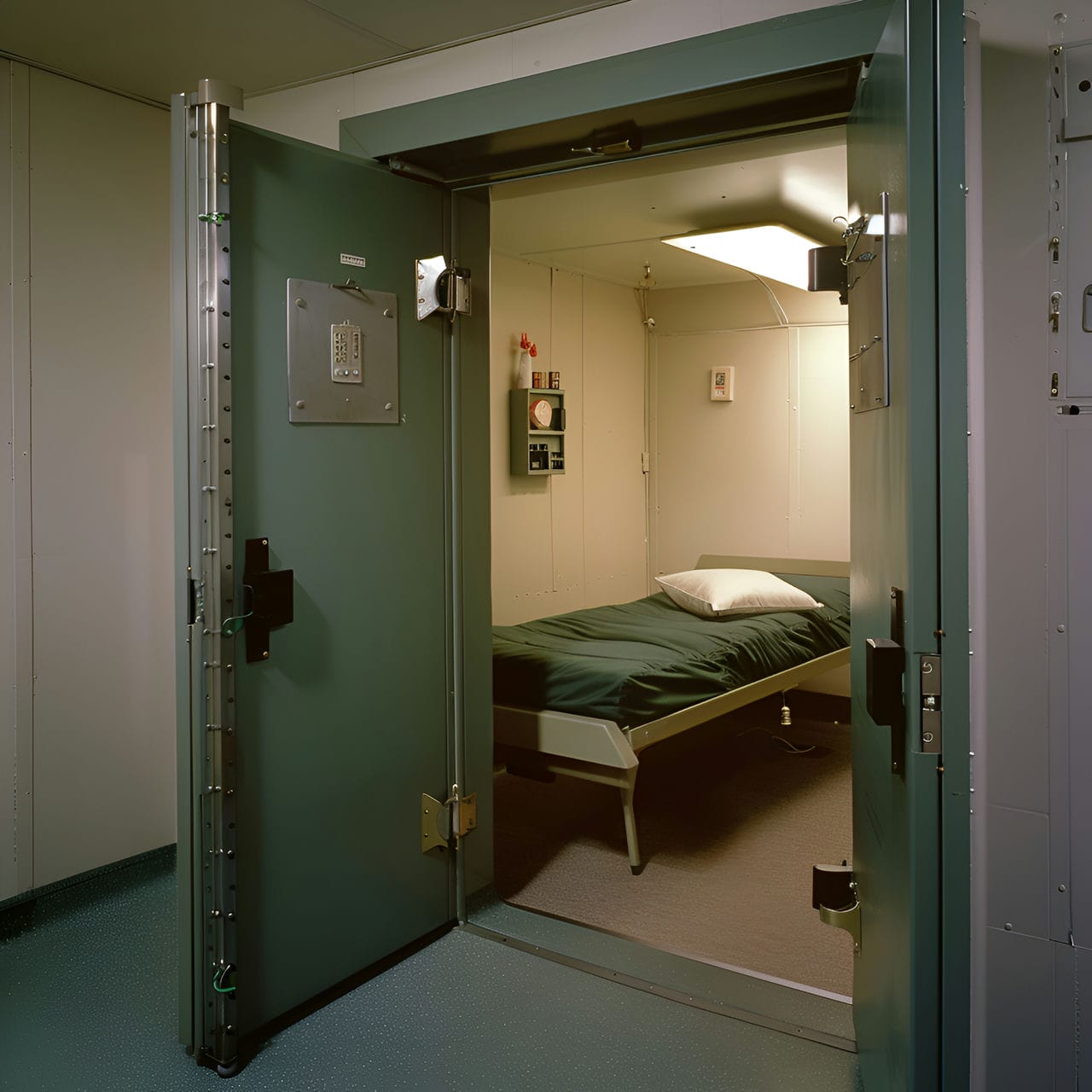
How much does it cost to hire an architect to renovate a panic room?
The average cost to hire an architect to renovate a panic room ranges from $1,500 (€1,350, £1,150) to $5,000 (€4,500, £3,800) based on the protective amenities and access points involved. Most accredited security advisors and architects charge $100 (€90, £75) to $200 (€180, £150) per hour. Specifying structural modifications to covertly enclose a 25 square foot (2 square meters) haven within existing properties while minimizing destructive renovations requires 10-15 hours for fees of $1,500 (€1,350, £1,150). Engineering luxury concealed underground or within master suites with redundant power backups, oxygen systems, and infrared perimeter sensors demands 20-30 hours, averaging $3,000 (€2,700, £2,300). High-end security designers collaborating on discreet fortified sanctuaries integrated into homes with rotating secret staircases, recessed private water sources, and CCTV camera networks often charge $5,000+ (€4,500+, £3,800+) given complex interconnected building trades coordinating across 30-40 hours. Modest embedded stronghold cocoons average $1,500 (€1,350, £1,150) to $3,000 (€2,700, £2,300), while integrating extensive autonomous infrastructure for underground facilities runs $3,000 (€2,700, £2,300) to $5,000 (€4,500, £3,800) for required engineered advising.
Is it worth it to hire an architect to upgrade a panic room?
Yes, hiring an architect to upgrade a panic room is worth it. Architects bring a deep understanding of materials and construction techniques crucial for creating a secure environment, such as reinforced walls, bulletproofing, and advanced locking mechanisms. Their knowledge extends to discreetly and effectively integrating sophisticated technology, including surveillance and communication systems. They are also adept at planning for contingencies like air filtration and power backups, which are vital for prolonged stays in the panic room. Architects ensure the renovation complies with relevant building codes and safety standards.
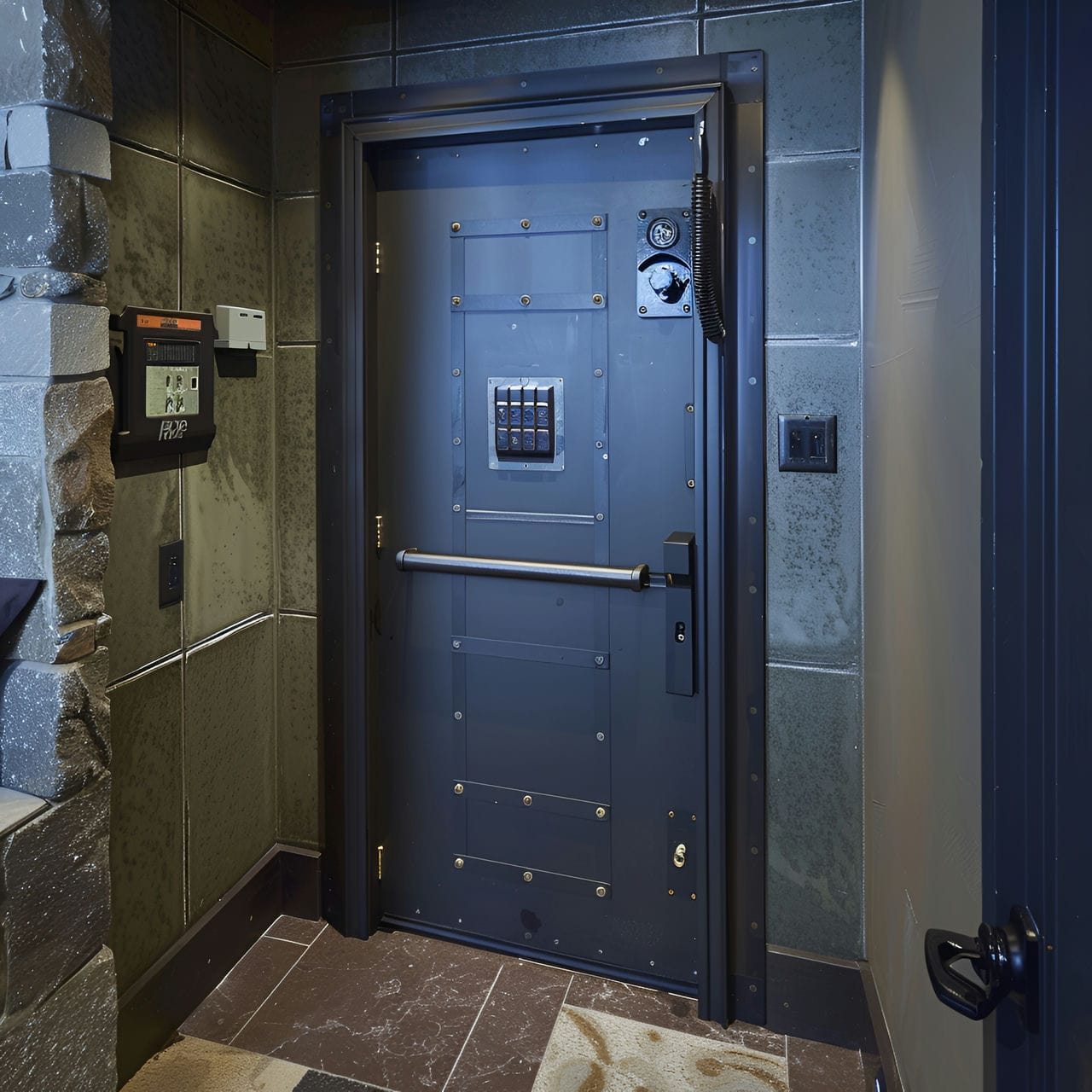
How long is needed to redecorate a panic room?
Redecorating a panic room takes about 3 to 8 weeks. Firstly, the complexity of the renovation is a primary determinant. Fundamental aesthetic changes like new paint or updating fixtures can be completed quickly, whereas more extensive upgrades involving security features or structural alterations require more time. Secondly, the size of the panic room plays a role. Smaller rooms can be redecorated faster, but the process will be lengthier if the space is larger or includes complex systems. Thirdly, the availability and delivery of specialized materials and equipment significantly impact the timeline. Panic rooms often require specific, high-security materials that may need to be more readily available and could have longer lead times. Fourthly, the involvement of specialized contractors or security experts can influence the schedule. The availability and coordination of these professionals, essential for ensuring the highest security standards, can extend the project duration. Lastly, unforeseen challenges or complications, such as structural issues or delays in custom material fabrication, can unexpectedly develop the timeline.
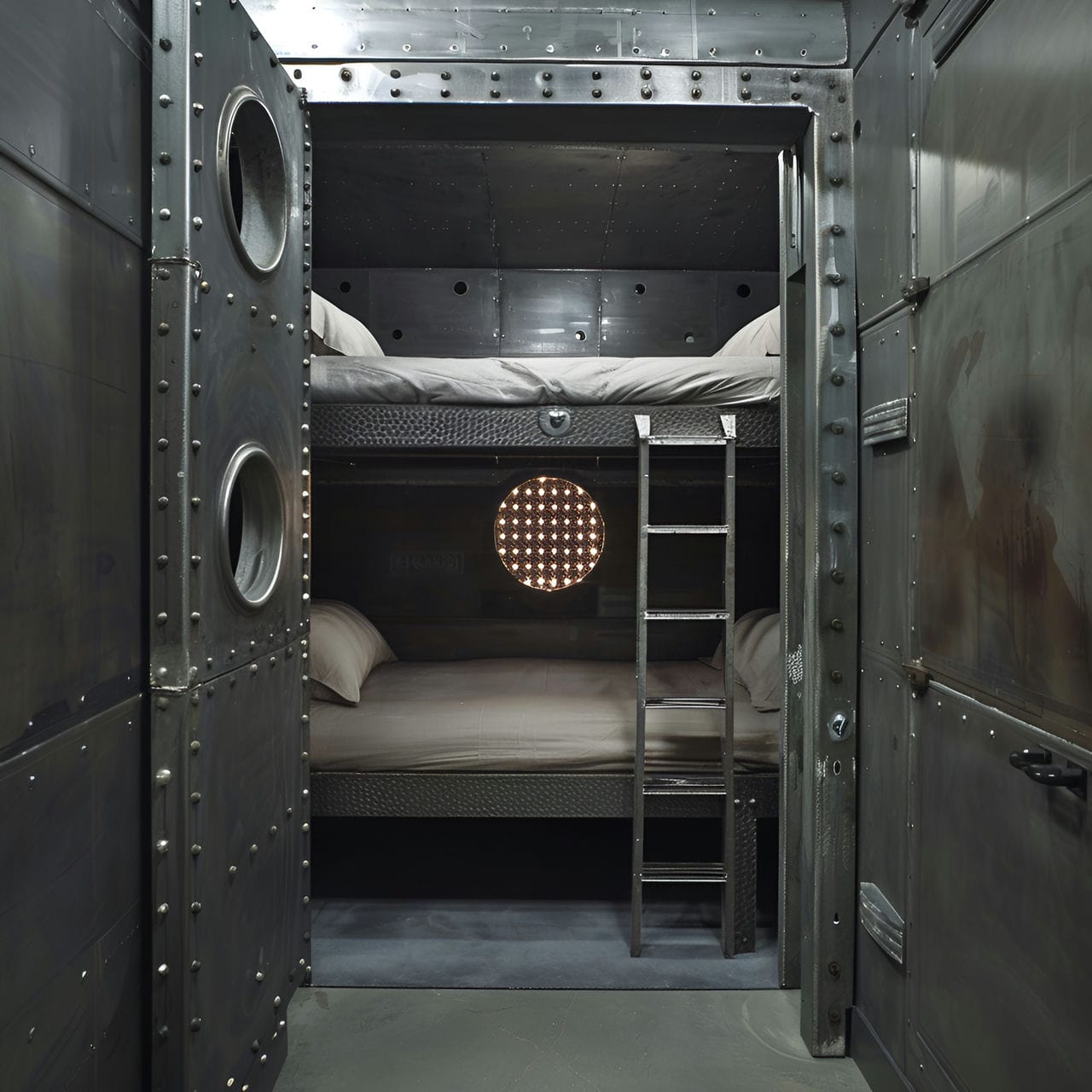
What are the struggles of the homeowner to redecorate a panic room?
Listed below are the struggles of the homeowner to redecorate a panic room:
- Ensuring optimal security: The primary struggle for homeowners redecorating a panic room is guaranteeing optimal security. They must select features and materials that enhance the room’s ability to protect against intruders or disasters.
- Balancing comfort with security: Balancing comfort with security is a significant challenge in panic room redecoration. Homeowners strive to create a space that is not only secure but also comfortable for potentially prolonged periods.
- Adhering to safety and building regulations: Homeowners need help to adhere to safety and building regulations when redecorating a panic room. They must ensure all modifications comply with local codes, which can be complex and involve navigating bureaucratic procedures.
- Managing space efficiently: Efficient space management is crucial in a panic room. Homeowners must strategically plan the layout to accommodate essential supplies and amenities within a limited area.
- Integrating advanced technology: Integrating advanced technology poses a challenge during panic room redecoration. Homeowners must incorporate systems like surveillance, communication, and emergency alerts, requiring technical knowledge and expertise.
- Ensuring ventilation and sustainability: Ensuring proper ventilation and sustainability in a panic room is a struggle. Homeowners must design a ventilation system that maintains air quality in a sealed environment, which is essential for health and safety during extended stays.
- Coordinating with specialists and contractors: Homeowners often need help to correspond with them for panic room redecoration. They need to hire professionals experienced in security and construction, ensuring they understand the unique requirements of a panic room.


